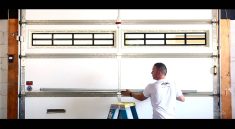Garage Doors and Parts – Spring tension adjustment is an essential part of maintaining a smooth-operating garage door. Without the correct spring tension, the door can become difficult to open or close, and may even cause damage over time. Adjusting the tension of the springs helps balance the door, ensuring it operates smoothly and efficiently. Proper tension allows the garage door to open and close with ease, reducing strain on the opener and increasing the door’s lifespan.
What is Spring Tension Adjustment?
Spring tension adjustment refers to the process of modifying the tension in the garage door springs. These springs are crucial for the door’s operation because they support the weight of the door and provide the necessary force to lift it. Over time, the tension in the springs may weaken, causing the door to become unbalanced and harder to move. Adjusting the spring tension helps maintain the proper balance, preventing the door from becoming too heavy or uneven during operation.
“read about: Handling Garage Door Tension Springs with Care: A Complete Tool Guide”
Why is Spring Tension Important for Your Garage Door?
The springs in your garage door are responsible for counteracting the weight of the door. They allow the door to open and close smoothly, without putting excess strain on the opener or the tracks. If the tension is too high, the door may be too difficult to lift. If the tension is too low, the door may not open properly and could even fall unexpectedly. Ensuring the proper tension balance is essential for both safety and functionality.
How to Identify When Spring Tension Needs Adjustment
There are several signs that your garage door may need spring tension adjustment. If you notice that the door opens unevenly, becomes sluggish, or has difficulty staying open, it may be a sign that the spring tension is off. Another indicator is if the door is not fully closing or opening, or if you hear strange noises during operation. In these cases, it’s crucial to adjust the spring tension to restore balance and prevent further damage.
Steps for Adjusting Spring Tension
- Safety First
Always prioritize safety when working with garage door springs. They are under high tension, and mishandling can cause injury. If you are not familiar with how to adjust the springs safely, it is advisable to hire a professional. - Release the Tension
Start by disengaging the garage door opener from the door. You can do this by pulling the emergency release cord. Next, use a wrench to release the tension on the springs. It’s important to release tension gradually and carefully. - Adjust the Tension
To adjust the tension, locate the spring adjustment bolts on each side of the door. Turn the bolts to increase or decrease the tension. If the door is not balanced, you may need to adjust each side equally for proper alignment. - Test the Door
After making adjustments, test the door to ensure it opens and closes smoothly. If the door feels unbalanced or difficult to operate, make further adjustments as needed. It’s important to fine-tune the tension to achieve the best result. - Reattach the Opener
Once the springs are properly adjusted, reattach the garage door opener and test the door’s operation once more. Ensure the door moves up and down with ease and that there are no signs of imbalance or strain.
When to Call a Professional for Spring Tension Adjustment
While some DIY enthusiasts may choose to adjust their garage door springs themselves, it is always best to seek professional help when in doubt. If you feel uncomfortable or unsure about making adjustments, it’s safer to call a professional garage door technician. They have the necessary tools and experience to make precise adjustments without risking damage or injury.
“Read more: Flat Tracker: Minimalist Speed for Dirt Racing”
The Importance of Regular Maintenance
Regular maintenance is key to keeping your garage door functioning properly. In addition to adjusting spring tension, it’s important to inspect the door, tracks, rollers, and cables regularly. Keeping the system well-maintained helps prevent problems before they occur, saving time and money in the long run.



